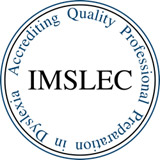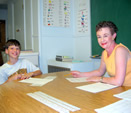Writing a Classic Orton Lesson
Plan
one/half day workshop $100.00 fee
8:30 a.m. - 12:30 p.m.
The sequencing, time allotment, and variety of language arts elements are crucial to the success of dyslexic students being taught to read, write, and spell by the Orton-Gillingham approach.
Elements:
- Drill - Visual, Auditory, and Kinesthetic
- Review
- New Information
- Reading Individual Words
- Dictated Spelling of Words, Phrases, and Sentences
- Oral Reading in Context
- Handwriting
- Silent Reading Comprehension
- Written Expression
Dyslexic students learn by multi-sensory teaching using each of the senses simultaneously to access the three association areas of the language center in the brain. The drills provide this, which has been shown by PET scans to increase blood flow to this area of the brain. The kinesthetic is the strongest sensory learning channel for dyslexic students.
Review is necessary to determine if the student remembers the new concept presented in yesterday's lesson and is ready to learn any new information.
Individual word recognition is a different skill than reading in context. Both must be practiced. Both words with new information and with knowledge taught in previous lessons but not yet automatically recognized must be included.
Dictation of words using these same phonemes is a must to anchor this knowledge in the student's brain. Individual words, phrases, and sentences need to be included. This practice refines auditory discrimination, strengthens visual memory for these words, and lengthens auditory memory.
Oral reading is used as a check on the student's fluency, intonation, and accuracy of reading the phonemes which he or she is being taught.
Handwriting is taught as students must be comfortable using manuscript and cursive writing. Cursive writing is anchored to the line, avoids reversals, and gives the student a gestalt of the words. Students will never read cursive writing unless they have been specifically taught it. Teaching it prevents later social embarrassment.
Silent reading comprehension needs practice just as do other language arts skills. There are specific strategies which can be taught and practiced one at a time, such as "finding the main idea". When this is mastered, another strategy is introduced. This continues until a variety of strategies are able to be applied to a single reading text.
Written expression and silent reading comprehension are usually taught on alternate days. There is time in the daily lesson for work on one paragraph at a time of a three paragraph essay.


 An
Orton Lesson
An
Orton Lesson